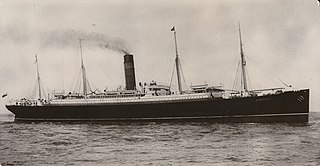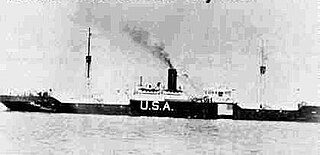
The Laconia incident was a series of events surrounding the sinking of a British passenger ship in the Atlantic Ocean on 12 September 1942, during World War II, and a subsequent aerial attack on German and Italian submarines involved in rescue attempts. RMS Laconia, carrying 2,732 crew, passengers, soldiers, and prisoners of war, was torpedoed and sunk by U-156, a German U-boat, off the West African coast. Operating partly under the dictates of the old prize rules, the U-boat's commander, Korvettenkapitän Werner Hartenstein, immediately commenced rescue operations. U-156 broadcast her position on open radio channels to all Allied powers nearby, and was joined by several other U-boats in the vicinity.

German submarine U-552 was a Type VIIC U-boat built for Nazi Germany's Kriegsmarine for service during World War II. She was laid down on 1 December 1939 at Blohm & Voss in Hamburg as yard number 528, launched on 14 September 1940, and went into service on 4 December 1940. U-552 was nicknamed the Roter Teufel after her mascot of a grinning devil, which was painted on the conning tower. She was one of the more successful of her class, operating for over three years of continual service and sinking or damaging 35 Allied ships with 164,276 GRT and 1,190 tons sunk and 26,910 GRT damaged. She was a member of 21 wolf packs.

RMS Laconia was a Cunard ocean liner, built by Swan, Hunter & Wigham Richardson as a successor of the 1911–1917 RMS Laconia. The new ship was launched on 9 April 1921, and made her maiden voyage on 25 May 1922 from Southampton to New York City. At the outbreak of the Second World War she was converted into an armed merchant cruiser, and later a troopship. She was sunk in the South Atlantic Ocean on 12 September 1942 by U-156. Some estimates of the death toll have suggested that over 1,658 people were killed when the Laconia sank. Hartenstein staged a rescue of the passengers and the crew of Laconia, which involved additional German U-boats and became known as the Laconia incident.
I-8 was an Imperial Japanese Navy Junsen III -type submarine commissioned in 1938 that served during World War II. Designed as submarine aircraft carriers, I-8 and her sister ship I-7 were the largest Japanese submarines to be completed before the outbreak of the war in the Pacific in 1941. With embarked floatplanes, I-8 participated in operations related to the attack on Pearl Harbor, patrolled off the United States West Coast, and took part in the Guadalcanal campaign and the Okinawa campaign.

German submarine U-66 was a Type IXC U-boat of Nazi Germany's Kriegsmarine during World War II. The submarine was laid down on 20 March 1940 at the AG Weser yard at Bremen, launched on 10 October and commissioned on 2 January 1941 under the command of Kapitänleutnant Richard Zapp as part of the 2nd U-boat Flotilla.
Vorwärts was a wolfpack of German U-boats that operated from 25 August to 26 September 1942, in the Battle of the Atlantic during World War II. They attacked several convoys, principally Convoy ON 127, sailing from Liverpool to New York, and sank fifteen ships for a total of 79,331 gross register tons (GRT), and damaged nine (81,141 GRT).

RMS Carpathia was a Cunard Line transatlantic passenger steamship built by Swan Hunter & Wigham Richardson in their shipyard in Wallsend, England.

SS City of Cairo was a British passenger steamship. She was sunk in the Second World War with heavy loss of life, most after the sinking, but before being rescued.

SS Robin Moor was a United States cargo steamship that was built in 1919 and sunk by a German U-boat in May 1941, several months before the US entered World War II.

SS California was a twin-screw steamer that D. and W. Henderson and Company of Glasgow built for the Anchor Line in 1907 as a replacement for the aging ocean liner Astoria, which had been in continuous service since 1884. She worked the Glasgow to New York transatlantic route and was sunk by the German submarine SM U-85 on 7 February 1917.
The SS Nerissa was a passenger and cargo steamer which was torpedoed and sunk on 30 April 1941 during World War II by the German submarine U-552 following 12 wartime voyages between Canada and Britain. She was the only transport carrying Canadian Army troops to be lost during World War II.
The SS David H. Atwater was a United States Merchant Marine coastal steamer which was sunk on 2 April 1942 by gunfire from German submarine U-552, commanded by Erich Topp, during World War II. The circumstances of the destruction of the vessel along with almost all of its crew fueled persistent rumours at the time of war crimes being perpetrated by Nazi Germany's U-boat fleets on the high seas against shipwrecked allied sailors.
German submarine U-177 was a Type IXD2 U-boat of Nazi Germany's Kriegsmarine during World War II. The submarine was laid down on 25 November 1940, at the DeSchiMAG AG Weser yard in Bremen, as yard number 1017. She was launched on 1 October 1941, and commissioned on 14 March 1942, under the command of Kapitänleutnant Wilhelm Schulze. After a period of training with the 4th U-boat Flotilla at Stettin, the boat was transferred to the 10th flotilla on 1 October 1942, and based at Lorient, for front-line service, she was then reassigned to the 12th flotilla at Bordeaux on 1 December.
An Empire ship is a merchant ship that was given a name beginning with "Empire" in the service of the Government of the United Kingdom during and after World War II. Most were used by the Ministry of War Transport (MoWT), which owned them and contracted their operation to various shipping companies of the British Merchant Navy.
The Torpedo Alley, or Torpedo Junction, off North Carolina, is one of the graveyards of the Atlantic Ocean, named for the high number of attacks on Allied shipping by German U-boats in World War II. Almost 400 ships were sunk, mostly during the Second Happy Time in 1942, and over 5,000 people were killed, many of whom were civilians and merchant sailors. Torpedo Alley encompassed the area surrounding the Outer Banks, including Cape Lookout and Cape Hatteras.
SS Point Pleasant Park was a merchant steamship constructed for Canada's Merchant Navy in 1942 during the Second World War as part of Canada's Park ship program. She carried a variety of wartime cargoes to Atlantic and Indian Ocean ports until the German submarine U-510 sank her off the coast of South Africa on 23 February 1945 as Point Pleasant Park was sailing independently from Saint John, New Brunswick to Cape Town. Point Pleasant Park was the last vessel sunk in South African waters during the Second World War.
SS Blitar was a Dutch cargo steamship that was launched in Rotterdam in 1922 and sunk in the Battle of the Atlantic in 1943. She is notable for having fought off three u-boats in succession for nearly ten hours before U-632 finally managed to sink her. 26 of Blitar's complement were killed.

MV Zaandam was a Dutch cargo liner. It was one of a pair of motor ships built for Holland America Line in 1938. In 1942 a U-boat sank her, causing the deaths of 135 of her passengers and crew. 164 people survived, including three who drifted on a life raft for 83 days before being rescued.
East Indian was a twin-screw cargo ship that was built in Japan in 1918 as Beikoku Maru. The United States Shipping Board (USSB) bought her that same year and renamed her East Indian. The Ford Motor Company bought her in 1925 to transport Ford products overseas. She was sunk in the South Atlantic in 1942. Only 16 of 74 people aboard survived.

SS Falaba was a British cargo liner. She was built in Scotland in 1906 and sunk by a U-boat in the North Atlantic in 1915. The sinking killed more than 100 people, provoking outrage in both the United Kingdom and United States.













